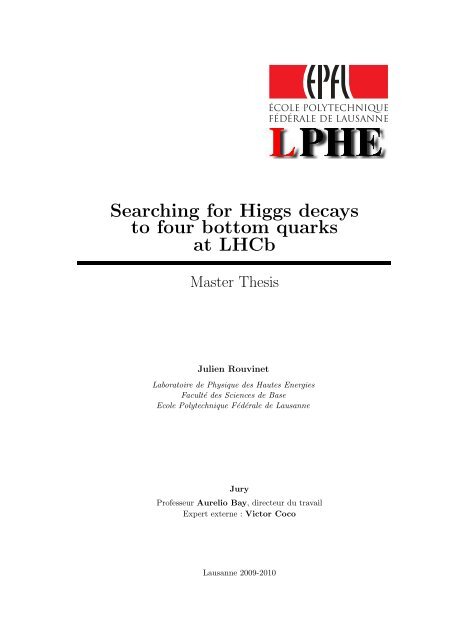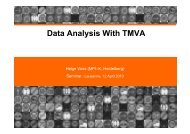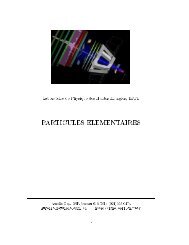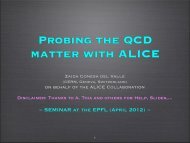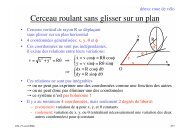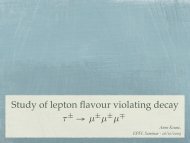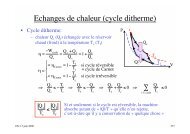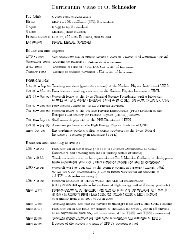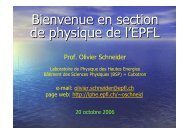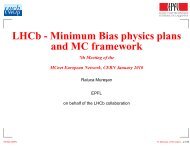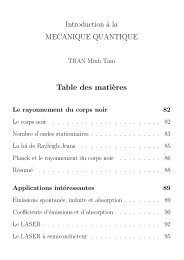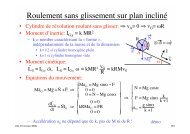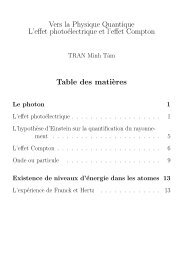PDF file: 2.9 Mbytes - Laboratoire de Physique des Hautes Energies ...
PDF file: 2.9 Mbytes - Laboratoire de Physique des Hautes Energies ...
PDF file: 2.9 Mbytes - Laboratoire de Physique des Hautes Energies ...
Create successful ePaper yourself
Turn your PDF publications into a flip-book with our unique Google optimized e-Paper software.
Searching for Higgs <strong>de</strong>cays<br />
to four bottom quarks<br />
at LHCb<br />
Master Thesis<br />
Julien Rouvinet<br />
<strong>Laboratoire</strong> <strong>de</strong> <strong>Physique</strong> <strong>de</strong>s <strong>Hautes</strong> <strong>Energies</strong><br />
Faculté <strong>de</strong>s Sciences <strong>de</strong> Base<br />
Ecole Polytechnique Fédérale <strong>de</strong> Lausanne<br />
Jury<br />
Professeur Aurelio Bay, directeur du travail<br />
Expert externe : Victor Coco<br />
Lausanne 2009-2010
Abstract<br />
In a recent paper[1], David E. Kaplan and Matthew McEvoy have claimed that it will<br />
be possible to <strong>de</strong>tect the Higgs boson in the LHCb experiment if its main <strong>de</strong>cay occurs<br />
through the channel h 0 → aa → b ¯ bb ¯ b for a Higgs mass not too far above current limits.<br />
Many mo<strong>de</strong>ls beyond the Standard Mo<strong>de</strong>l, like NMSSM 1 , little Higgs, composite Higgs<br />
or any mo<strong>de</strong>l where new light scalar (or pseudo-scalar) particles are coupled to the Higgs<br />
incorporate such phenomenology. The main feature of the LHCb experiment is the reconstruction<br />
of b particles through a proper b-tagging. The goal of this Master Thesis is to<br />
test this hypothesis through a preliminary study of this particular Higgs <strong>de</strong>cay mo<strong>de</strong> using<br />
Pythia. A background contribution is generated using Alpgen. b-jets are reconstructed<br />
in or<strong>de</strong>r to recover the pseudo-scalar particle a. Two a candidates are subsequently combined<br />
to obtain the Higgs. Finally, a Toy Monte Carlo is ma<strong>de</strong> to asses the capability to<br />
extract the signal.<br />
1 Next-to-Minimal SuperSymmetric Standard Mo<strong>de</strong>l
Contents<br />
1 The Large Hadron Colli<strong>de</strong>r and The LHCb experiment 5<br />
1.1 The LHC . . . . . . . . . . . . . . . . . . . . . . . . . . . . . . . . . . . . . 5<br />
1.2 The LHCb Experiment . . . . . . . . . . . . . . . . . . . . . . . . . . . . . . 6<br />
2 Theoretical overview 9<br />
2.1 Standard Mo<strong>de</strong>l and Higgs Boson . . . . . . . . . . . . . . . . . . . . . . . . 9<br />
2.1.1 The Standard Mo<strong>de</strong>l . . . . . . . . . . . . . . . . . . . . . . . . . . . 9<br />
2.1.2 The Higgs Mechanism . . . . . . . . . . . . . . . . . . . . . . . . . . 10<br />
2.2 The Higgs to four b <strong>de</strong>cay . . . . . . . . . . . . . . . . . . . . . . . . . . . . 11<br />
2.2.1 QCD backgrounds to h 0 → aa → b ¯ bb ¯ b . . . . . . . . . . . . . . . . . 11<br />
3 Events generation using Pythia and Alpgen 13<br />
3.1 Generation of signal events using Pythia . . . . . . . . . . . . . . . . . . . 13<br />
3.2 Background contributions using Alpgen . . . . . . . . . . . . . . . . . . . . 15<br />
3.3 Number of generated events . . . . . . . . . . . . . . . . . . . . . . . . . . 16<br />
3.4 MC-events generation and analysis . . . . . . . . . . . . . . . . . . . . . . . 16<br />
4 Study of the h 0 → aa → b ¯ bb ¯ b signature in LHCb 19<br />
4.1 b quarks analysis . . . . . . . . . . . . . . . . . . . . . . . . . . . . . . . . . 19<br />
4.2 Jets reconstruction . . . . . . . . . . . . . . . . . . . . . . . . . . . . . . . . 21<br />
4.3 Reconstruction of the a . . . . . . . . . . . . . . . . . . . . . . . . . . . . . 26<br />
4.3.1 Selection cuts . . . . . . . . . . . . . . . . . . . . . . . . . . . . . . . 27<br />
4.4 Higgs reconstruction . . . . . . . . . . . . . . . . . . . . . . . . . . . . . . . 30<br />
4.5 Number of events . . . . . . . . . . . . . . . . . . . . . . . . . . . . . . . . . 31<br />
4.6 Muons plots . . . . . . . . . . . . . . . . . . . . . . . . . . . . . . . . . . . . 32<br />
4.7 Extraction of the signal: a Toy Monte-Carlo study . . . . . . . . . . . . . . 34<br />
4.7.1 A statistical enhancement trick . . . . . . . . . . . . . . . . . . . . . 34<br />
4.7.2 TMC results . . . . . . . . . . . . . . . . . . . . . . . . . . . . . . . 35<br />
5 Conclusion 39<br />
A Alpgen parameters 41<br />
B Other plots 43<br />
3
Chapter 1<br />
The Large Hadron Colli<strong>de</strong>r and<br />
The LHCb experiment<br />
1.1 The LHC<br />
Figure 1.1: The Large Hadron Colli<strong>de</strong>r and its associated experiments<br />
The LHC is the CERN’s 1 new circular hadrons colli<strong>de</strong>r located beneath the Franco-<br />
Swiss bor<strong>de</strong>r near Geneva Switzerland. It has been commissioned on autumn 2008 and<br />
reopened on November 2009 after some adjustments. This colli<strong>de</strong>r is the world’s largest<br />
and highest-energy particles accelerator. It lies in a tunnel of 27 km of circumference and<br />
will produce collisions between protons at an energy of 7 T eV in the center of mass frame<br />
and between P b ions at an energy of 574 T eV per nucleus. The most famous question<br />
which is likely to be answered through this incredibly technical challenge concerns the<br />
existence and properties of the Higgs boson. Physicists are also looking for an explanation<br />
of the imbalance between matter and antimatter in the Universe. Moreover, because of<br />
the huge available energy, new types of particles (for instance SUSY’s) may be produced.<br />
Properties of the quark-gluon plasma will also be hunted down. Therefore, to perform<br />
these crucial break-throughs, four major experiments have been installed along the cave.<br />
1 Centre Européen pour la Recherche Nucléaire: international collaboration created in 1954<br />
5
ATLAS, A Toroidal LHC ApparatuS, is <strong>de</strong>signed to observe phenomena involving<br />
massive particles, in particular the electroweak interaction symmetry breaking through<br />
the Higgs mechanism. It might shed light on theories beyond the Standard Mo<strong>de</strong>l. This<br />
five stories sized <strong>de</strong>tector is <strong>de</strong>signed to measure the broa<strong>de</strong>st range of energy signals<br />
rather than focusing on a specific process.<br />
The second experiment is CMS, the Compact Muon Solenoid. It also is a general<br />
purpose <strong>de</strong>tector <strong>de</strong>signed with the same goals than ATLAS. These two <strong>de</strong>tectors will<br />
complement each other, hopefully finding new physics and discovering the Higgs boson.<br />
The third one is ALICE, A Large Ion Colli<strong>de</strong>r Experiment. It will study P b − P b<br />
collisions in or<strong>de</strong>r to investigate the quark gluon plasma. This state of matter is supposed<br />
to have been generated close to the Big Bang.<br />
Finally, the LHCb, Large Hadron Colli<strong>de</strong>r beauty, is <strong>de</strong>signed to un<strong>de</strong>rstand the<br />
matter-antimatter asymmetry through the study of CP violation in B-mesons systems.<br />
More <strong>de</strong>tails are given on the next section.<br />
1.2 The LHCb Experiment<br />
Figure 1.2: The LHCb experiment in the vertical plane<br />
The LHCb is a single arm forward spectrometer with an angular coverage (acceptance)<br />
of 15 < θ < 330 mrad corresponding to a pseudo rapidity of 1.8 < η < 4.9 where<br />
η = −ln(tan(θ/2)). This angle seems small but is justified by the fact that b-hadrons<br />
have a transverse momentum smaller than their longitudinal momentum. The <strong>de</strong>tector is<br />
optimized to exploit the large number of b quarks produced during the collision. The LHCb<br />
luminosity is lower than the luminosity potential of the LHC. It is set to L LHCb = 2 · 10 32<br />
cm −2 s −1 to obtain an average of one p−p interaction per crossing. We can notice different<br />
components:<br />
6
• The Vertex Locator (VELO): Surrounding the interaction point, it is ma<strong>de</strong> of 25<br />
silicon stations of 200 µm of thickness. The VELO allows the reconstruction of the<br />
position of the secondary vertices with a resolution of about 300 µm.<br />
• RICH1 and RICH2: These two Ring Imaging Cherenkov <strong>de</strong>tectors allow particles<br />
i<strong>de</strong>ntifications.<br />
• TT, T1, T2 and T3 trackers: measure the momentum of charged particles <strong>de</strong>viated<br />
by a magnetic field.<br />
• The Scintillator Pad Detector (SPD): differentiates charged particles from neutral<br />
ones.<br />
• The PreShower (PS): It achieves the pre-<strong>de</strong>tection of electromagnetic showers and<br />
distinguishes between electrons and pions.<br />
• The ECAL and HCAL: These two calorimeters measure the total amount of energy<br />
<strong>de</strong>posed by the electrons, photons and hadrons.<br />
• The M1-M5 Muons <strong>de</strong>tector: Positioned at the end of the <strong>de</strong>tector, they measure<br />
the total energy of muons, particles weakly interacting.<br />
Once the collisions start, it is important to select the events to store because if everything<br />
was to be saved, the amount of data would be of the or<strong>de</strong>r of 40 T B/s. To achieve<br />
the reduction, two stages of trigger are performed. The first level is interesting because it<br />
makes the study of the Higgs <strong>de</strong>cay into four b quarks worth at LHCb. The Level-0 Trigger<br />
is based on calorimeter and muon chamber information in or<strong>de</strong>r to reduce the event rate<br />
down to 1 MHz by requiring a muon, an electron, a photon or a hadron with an high<br />
transverse momentum and transverse energy. Tracks associated with b-hadron <strong>de</strong>cays fulfill<br />
these conditions. Also, in inclusive production, the Higgs is significantly boosted along<br />
the z-axis and thus, at least one b quark often lives at large pseudo-rapidity, and therefore<br />
excellent tracking and vertexing in the forward region are crucial for the kind of signal we<br />
are interested in[1].<br />
More <strong>de</strong>tails on the LHCb experiment and on the trigger system can be found on its<br />
internet website or in [3].<br />
7
Chapter 2<br />
Theoretical overview<br />
This chapter consists in a very brief presentation of the Standard Mo<strong>de</strong>l of particles physics<br />
along with a quick introduction to the Higgs mechanism. Plenty of good books can be<br />
consulted on these subjects. Therefore, only the material useful for this work is <strong>de</strong>scribed.<br />
2.1 Standard Mo<strong>de</strong>l and Higgs Boson<br />
2.1.1 The Standard Mo<strong>de</strong>l<br />
The Standard Mo<strong>de</strong>l of particle physics (or SM) is a relativistic quantum field theory which<br />
<strong>de</strong>scribes three of the four fundamental interactions of Nature and the elementary particles<br />
that un<strong>de</strong>rgo these interactions. This mo<strong>de</strong>l is a gauge theory which is in relatively good<br />
agreement with the present (beginning of 2010) experimental results. The SM gauge group<br />
is:<br />
Electro−weak interaction<br />
<br />
GSM = SU(3)c<br />
<br />
× SU(2) × U(1)<br />
Strong interaction (color)<br />
SU(3)c is the group associated with Quantum Chromo Dynamics (the subscript c<br />
stands for color, which is the name of the strong charge) while SU(2) × U(1) is associated<br />
with both the electromagnetic and weak forces. The mo<strong>de</strong>l also <strong>de</strong>scribes the elementary<br />
particles. A list of those particles and their masses is given in Figure 2.1.<br />
9
Leptons<br />
Quarks<br />
Particle Mass [MeV/c 2 ]<br />
e - 0.511<br />
! e
2.2 The Higgs to four b <strong>de</strong>cay<br />
Assuming that the SM is correct up to 1 T eV , we know quite well the production cross<br />
section and the <strong>de</strong>cay width of the Higgs for any given mass. Nevertheless, these quantities<br />
are very sensitive to the physics hid<strong>de</strong>n beyond the SM. If we assume the existence of a<br />
light neutral pseudo scalar particle having a mass about half the Higgs mass, the Higgs<br />
could <strong>de</strong>cay dominantly into this particle without affecting the Z width too much. This<br />
particle will be called a through all this work. Many mo<strong>de</strong>ls inclu<strong>de</strong> such phenomenology.<br />
Let us name for example the NMSSM, Higgs composite and little Higgs theories. We will<br />
assume that the branching ratio of the Higgs to the a is equal to one and that the a is<br />
forced to <strong>de</strong>cay into a b − ¯ b pair. The large number of mo<strong>de</strong>ls containing this physics can<br />
be approximated simply by adding this a to the SM. The coupling to the Higgs is then<br />
simply:<br />
This term will generated a mass given by:<br />
1<br />
2 λa2 H † H (2.1)<br />
m 2 a = 1<br />
2 λv2<br />
(2.2)<br />
v 246 GeV being the Higgs vacuum expectation value. The <strong>de</strong>cay rate for this process<br />
is:<br />
Γ(h → aa) 1<br />
32π<br />
λ 2 v 2<br />
mh<br />
<br />
1 − 4m2 a<br />
m 2 h<br />
(2.3)<br />
This width dominates the Higgs <strong>de</strong>cay comparing to the total <strong>de</strong>cay rate of a (e.g. 115<br />
GeV ) SM Higgs if the coupling to the scalar is λ > 0.25 1 .<br />
2.2.1 QCD backgrounds to h 0 → aa → b ¯ bb ¯ b<br />
In addition to the signal, we have to consi<strong>de</strong>r the existence of an irreducible QCD b ¯ bb ¯ b<br />
background because these four b could be mistaken as resulting from a <strong>de</strong>cays. Hence, it<br />
is necessary to inclu<strong>de</strong> those b to the study.<br />
We must also inclu<strong>de</strong> a b ¯ bt¯t component because the top quark usually <strong>de</strong>cays into a b<br />
quark which will give birth to another source of background. However, it appears that<br />
this source is negligible, because its production cross section 2 is small (as is illustrated in<br />
table 4.1).<br />
Another source of background is related to the limited capability to discriminate between b<br />
and c jets. The LHCb experiment is <strong>de</strong>signed to recognize b events, this is called b-tagging.<br />
Nevertheless, the efficiency of b-tagging is not 100%. Sometimes, c jets are mistaken to be<br />
b jets. In a recent paper (see ref.[5]), A.Bay and C. Potterat <strong>de</strong>scribe an algorithm for the<br />
<strong>de</strong>termination of the seeds to be used in the reconstruction of b jets. They show that the<br />
typical efficiency to discover b jets is about 70%. The probability to confuse c with b jets<br />
is about 30%. Enhanced flavour criteria will be consi<strong>de</strong>red in further studies to improve<br />
those efficiencies. Taking this fact into consi<strong>de</strong>ration leads us to add a b ¯ bc¯c background<br />
contribution to our analysis.<br />
1 see [1] from which this section is strongly inspired<br />
2 The cross section given by Alpgen for this process is 3, 78 pb.<br />
11
V ∗<br />
V ∗<br />
Chapter 3<br />
Events generation using Pythia<br />
and Alpgen<br />
To study the Higgs <strong>de</strong>cay into four b-quarks, the standalone computer program Pythia<br />
version 6.325 is used. We have chosen this version to insure compatibility with Alpgen<br />
version 2.13, which is a generator for hard multiparton processes in hadronic collisions[4].<br />
These two generators are based on Monte Carlo methods. The energy in the center of<br />
mass frame of the two incoming protons is √ s = 14 T eV , corresponding to the maximal<br />
energy that should be reached by the LHC at the end of the year 2012.<br />
3.1 Generation of signal events using Pythia<br />
The various and most important parameters used to generate signal events are <strong>de</strong>scribed<br />
here. First, the <strong>de</strong>cay <strong>file</strong> used by Pythia has to be modified in or<strong>de</strong>r to force the Higgs to<br />
turn into two a particles. Then, each a has to <strong>de</strong>cay into a b−¯b pair. Therefore, a new bloc<br />
is ad<strong>de</strong>d in the <strong>de</strong>cay <strong>file</strong>, corresponding to the a (associated to the i<strong>de</strong>ntification number<br />
σh0 pbarn → 5.9 · 10<br />
n°35). The branching ratio for the <strong>de</strong>cay of a into four b-quarks is set equal to one. For<br />
the Higgs <strong>de</strong>cay into two a, the branching ratio is set to 0.97 because the inverse process<br />
of the gluons fusion used to generate the Higgs has to be permitted. The Higgs mass and<br />
5<br />
σbb 2.45 · 108 pbarn → 1.5 · 1012 σZW 4.33 · 106 pbarn → 2.7 · 10 10<br />
the a mass are both parameters. We will vary them to see how the kinematics changes.<br />
σtt 2.75 · 103 pbarn → 1.7 · 107 b/t<br />
q<br />
h 0<br />
q<br />
q<br />
h 0<br />
q<br />
We have consi<strong>de</strong>red two different masses for the Higgs: mh = 115 and 125 GeV c −2 and<br />
three different masses for a: ma = 20, 25 and 35 GeV c −2 . This is ma<strong>de</strong> by changing the<br />
masses in the <strong>de</strong>cay <strong>file</strong> used by the program.<br />
The Higgs boson is produced by Pythia through gluons fusion 1 . The associated Feynman<br />
diagram is shown in Figure 3.1.<br />
g q<br />
h 0<br />
g q<br />
q<br />
q<br />
V ∗<br />
b/t<br />
V<br />
1 by setting MSUB(102) = 1<br />
h 0<br />
g q<br />
q<br />
g q<br />
q<br />
gg<br />
Figure 3.1: Feynman diagram of gluons fusion<br />
q<br />
q q<br />
13<br />
h 0<br />
h 0
After production, the program computes the hadronization and the <strong>de</strong>cay processes of<br />
the event. An example of event can be found in [3].<br />
The most relevant configuration parameters used for the simulation are given in table<br />
3.1.<br />
Parameter Value Explanation<br />
MSTP(2) 2 Compute αs to second or<strong>de</strong>r<br />
MSTP(61) 1 QED and QCD initial state radiation<br />
MSTP(71) 1 QED and QCD final state radiation<br />
MSTP(81) 1 Multiple interactions<br />
MSTP(82) 3 Structure of multiple interactions<br />
MSTP(111) 1 Fragmentation and <strong>de</strong>cay<br />
MSTP(131) 0 Only one event is generated at a time<br />
MSTP(151) 1 Program execution<br />
MSTU(21) 1 Check on possible errors during program execution<br />
PARP(67) 1.0 ·Q 2 : maximum parton virtuality allowed in time-like showers<br />
PARP(81) 21 Effective min. transverse momentum p⊥min for multiple interactions<br />
PARP(82) 4.50 Regularization scale p⊥0 for multiple interactions<br />
PARP(85) 0.33 Related to gluons in multiple interactions<br />
PARP(86) 0.66 Related to gluons in multiple interactions<br />
PARP(89) 14000.0 Reference energy scale<br />
PARP(90) 0.116 Power of the energy-rescaling term of the p⊥min and p⊥0 parameters<br />
PARP(91) = 1.0 Width of Gaussian primordial k⊥ distribution insi<strong>de</strong> hadron<br />
PARP(131) 0.0048 Luminosity for pile-up events<br />
PARP(151) 0.007 [mm] σx of beam<br />
PARP(152) 0.007 [mm] σy of beam<br />
PARP(153) 0.059 [mm] σz of beam<br />
PARP(154) 0 [mm/c] σt of beam<br />
MSTJ(1) 1 String fragmentation according to the Lund mo<strong>de</strong>l<br />
MSTJ(26) 0 No B– ¯ B mixing in <strong>de</strong>cays.<br />
PARJ(11) 0.5 Prob. spin 1 light meson (containing u and d quarks only)<br />
PARJ(12) 0.4 Prob. spin 1 strange meson<br />
PARJ(13) 0.79 Prob. spin 1 charm or heavier meson<br />
PARJ(14) 0.0 Prob. spin 0 meson is prod. with orb. ang. mom. 1, for total spin 1<br />
PARJ(15) 0.018 Related to probability of specific meson production<br />
PARJ(16) 0.054 Related to probability of specific meson production<br />
PARJ(17) 0.131 Related to probability of specific meson production<br />
PARJ(33) 0.4 Define the remaining energy below which 2 final hadrons are formed<br />
Table 3.1: Most important configuration parameters used in Pythia. These parameters<br />
are directly implemented into the Fortran co<strong>de</strong>. For more <strong>de</strong>tails on the list of parameters<br />
and on their usage see [8].<br />
14
3.2 Background contributions using Alpgen<br />
Alpgen [4] is <strong>de</strong>dicated to the study of multiparton hard processes in hadronic collisions.<br />
It is based on the ALPHA algorithm. Therefore, it constitutes the perfect tool to generated<br />
b ¯ bb ¯ b, b ¯ bc¯c and b ¯ bt¯t backgrounds. The generation is divi<strong>de</strong>d into two phases. The first<br />
one produces weighted events whereas the second produces the unweighted events that<br />
will be showered through Pythia. The first phase is initialized by a <strong>file</strong> containing the<br />
informations given in table 3.2. An example of <strong>file</strong> is given in Appendix A.<br />
Parameter and explanation Value<br />
imo<strong>de</strong>, 1 generates weighted events and writes to <strong>file</strong> for later unweighting 1<br />
Label for the produced <strong>file</strong>s bbbb<br />
Grid: The generator will use a new grid 0<br />
Number of events per iteration and number of warm-up iterations 100000000 2<br />
Number of events generated after warm-up 100000000<br />
ihvy: choose the heavy flavour type, here b quark 5<br />
ihvy2: same as before to insure b ¯ bb ¯ b production 5<br />
ebeam: beam energy in the center of mass frame 7000.0<br />
ih2: Select pp collisions 1<br />
ndns: Parton <strong>de</strong>nsity function, CTEQ5L * is used 5<br />
njets: Number of light jets 0<br />
etabmax: Pseudo rapidity η maximum of b quarks 4.5<br />
drbmin: ∆R minimum between b quarks 0.1<br />
ptbmin: Minimum transverse momentum of b quarks 10<br />
Table 3.2: Chosen parameters for the first generation phase in Alpgen. These are the<br />
parameters for the b ¯ bb ¯ b component of the background leading to 703 ′ 906 events generated.<br />
For a complete list and more explanations see [4] and [9]. The parameters for the b ¯ bc¯c<br />
and b ¯ bt¯t components are given in Appendix A.<br />
After the first phase, weighted events are produced. The program subsequently can<br />
perform the unweighting of those events. The names of the weighted <strong>file</strong>s are also used<br />
for the names of the output <strong>file</strong>s. Those <strong>file</strong>s are:<br />
• qqqq.stat: Contains value of the input parameters, list of hard process selected<br />
and generation cuts. It then reports the results of each individual integration cycle,<br />
with total cross sections and individual contributions from the allowed subprocesses.<br />
Contains maximum weights of the various iterations, the corresponding unweighting<br />
efficiencies, and the value of the cross-section accumulated over the various iterations<br />
weighted by the respective statistical errors.<br />
• qqqq.grid1 and qqqq.grid2: The phase-space is discretized and parameterized<br />
by a multi-dimensional grid. Those <strong>file</strong>s contain <strong>de</strong>tails on the grid and on its<br />
parametrization.<br />
• qqqq.par and qqqq unw.par: Inclu<strong>de</strong> run parameters (beam energies and types,<br />
generation cuts, etc), phase-space grids, cross-section and maximum-weight information.<br />
15
• qqqq.wgt: Stores the two seeds of the random number generation, the event weight<br />
and the value of other parameters of the event.<br />
• qqqq unw.stat: Inclu<strong>de</strong>s cross sections, maximum weight, etc...<br />
• qqqq.unw: List of unweighted events, including event kinematics, flavor and color<br />
structure and event weight.<br />
Finally, these events are transfered to Pythia via the qqqq unw.par and qqqq.unw<br />
<strong>file</strong>s.<br />
3.3 Number of generated events<br />
We have produced 10 ′ 000 signal events. 700 ′ 000 b ¯ bb ¯ b background events and 500 ′ 000 b ¯ bc¯c<br />
background events have been treated with Pythia after generation by Alpgen.<br />
3.4 MC-events generation and analysis<br />
Once the events are generated, the program should be capable to sort the particles, perform<br />
some treatments like jet reconstructions and store the interesting informations in <strong>file</strong>s that<br />
can be used for further analysis. In this section, the different algorithms used to study<br />
the characteristics of both the signal and the background are enumerated and briefly<br />
presented.<br />
Events generation<br />
The program written for this work 2 offers two different options. The first one is the<br />
generation of signal events that can be stored or directly treated by various algorithms.<br />
It manages the interface with Pythia and the selection of the <strong>de</strong>cay <strong>file</strong>. The program<br />
checks that h → aa events have been produced and counts these events for statistical<br />
purposes.<br />
The second option passes the background events produced by Alpgen to Pythia for<br />
hadronization.<br />
Acceptance<br />
The LHCb experiment has a limited angular coverage implemented in the co<strong>de</strong> by checking<br />
that every interesting particle belongs to the cone <strong>de</strong>fined by:<br />
15 < θ < 390 mrad (3.1)<br />
which is a little bit bigger than the LHCb acceptance to allow for boundary effects studies<br />
in further analysis. This condition implies that only particles lying insi<strong>de</strong> the cone are<br />
consi<strong>de</strong>red.<br />
2 in the FORTRAN language (see [7])<br />
16
Searching the muons and their genealogy<br />
In the article [1] on which this analysis is inspired, the LHCb experiment is chosen because<br />
of its inclusive muon trigger which acts as an ”existence proof” to save the data to disc.<br />
Therefore, the program looks for muons and checks if they are products of the <strong>de</strong>cay of<br />
a b-hadron, coming from the <strong>de</strong>cay product of one a. Then, a consistency check is ma<strong>de</strong><br />
by verifying that the inclusive branching ratio of b hadrons to muons is about 11%. It<br />
is in<strong>de</strong>ed the case for every simulation we ma<strong>de</strong>. Finally, informations are stored and<br />
statistics are computed.<br />
Jet reconstruction<br />
Each of the b quarks produced is used as a seed for the jet reconstruction. Of course, in<br />
real life, the b quarks are not directly observable and it is only through jet reconstruction<br />
that information on the Higgs and a masses can be gathered. The co<strong>de</strong> contains different<br />
algorithms for the reconstruction. Details will be given in the chapter 4.<br />
Saving the informations<br />
All important data are saved in (.hbk) <strong>file</strong>s that can be analyzed later 3 . We construct<br />
histograms of the kinematical variables of jets, b quarks, muons, a and Higgs. The energy<br />
and momentum are saved along with different sets of variables as the angular distance<br />
between particles. It is also possible to store the full event generations in (.dat) <strong>file</strong>s that<br />
can be read later for analysis.<br />
The mismatch algorithm<br />
This simple algorithm is the implementation of the possibility that the <strong>de</strong>tector misinterprets<br />
a c quark to be a b quark. A b quark has roughly 70% of chance to be correctly<br />
recognized. A c quark has a probability of 30% to be interpreted as a b quark. This fact is<br />
explained in [5], which <strong>de</strong>scribes a preliminary study of an algorithm allowing b jet reconstruction.<br />
Researches are being ma<strong>de</strong> on this subject and progresses are expected, leading<br />
to a better reconstruction and therefore reducing the impact of the b ¯ bc¯c background consi<strong>de</strong>red<br />
here.<br />
In practice, the algorithm overwrites the i<strong>de</strong>ntification number of the c quarks (from 4 to<br />
5), leading the program to consi<strong>de</strong>r c jets as b ones. The possibility to mix up the c and<br />
b quarks is offered at the beginning of the treatment of the background.<br />
3 using either Paw or Root; these two programs enable histograms and statistical treatments of data<br />
17
Chapter 4<br />
Study of the h 0 → aa → b ¯ bb ¯ b<br />
signature in LHCb<br />
This chapter <strong>de</strong>scribes the signature of the h0 → aa → b¯bb¯b physical process as well as<br />
the contribution of different backgrounds. It also proposes a Toy Monte Carlo analysis to<br />
study the efficiency of the signal <strong>de</strong>tection. For the analysis, we choose mh = 115 GeV/c2 and ma = 20 GeV/c2 . We have also generated events with mh = 125 and ma = 25 and<br />
35 GeV/c2 . For those cases, the analysis is essentially the same, therefore, only the first<br />
set of parameters is fully <strong>de</strong>scribed here. To follow the work presented in [1], it would be<br />
interesting to complete the study for those different masses too and see the effect of their<br />
variations on the efficiency of the method illustrated in what follows.<br />
The b quarks hadronize into ”jets”. A technique to reconstruct jets is based on the cone<br />
algorithm: particles are gathered when they fall insi<strong>de</strong> a cone of aperture ∆R in (η, φ)<br />
space 1 . The angular distance is <strong>de</strong>fined by Eq. 4.1.<br />
<br />
∆Rij = (ηi − ηj) 2 + (φi − φj) 2 (4.1)<br />
For simplicity, we consi<strong>de</strong>r events where the four b quarks are either produced by the<br />
signal or by background contributions. Mixed possibilities where, for instance, a b is the<br />
result of another process and the three others are signal ones are not discussed. Of course,<br />
these more complicated situations have to be consi<strong>de</strong>red in further studies.<br />
In the following, the signal and background distributions are normalized to 1 unless<br />
otherwise is specified.<br />
4.1 b quarks analysis<br />
We first consi<strong>de</strong>r the kinematics of the b quarks. Only events with four b quarks insi<strong>de</strong> the<br />
LHCb acceptance are consi<strong>de</strong>red 2 . This corresponds to about 7% of the generated signal<br />
events and 3.5% of b ¯ bb ¯ b and b ¯ bc¯c generated background events.<br />
First, the angle and ∆R distributions are represented in or<strong>de</strong>r to find a good strategy<br />
to reconstruct jets. Obviously, if the b are produced close to each other, their jets will<br />
overlap and it will be difficult to reconstruct them. Figure 4.1 shows the angular and<br />
∆R distributions of the b of the signal and also of the b coming from the b ¯ bb ¯ b and b ¯ bc¯c<br />
backgrounds. A jet is generally constructed with a cone radius of Rcone = 0.6. Therefore,<br />
1 See Ref.[2] and [5]<br />
2 Let us recall that the enlarged acceptance is 15 < θ < 390 mrad<br />
19
two jets overlap if ∆R(b1, b2) < 2 · Rcone = 1.2. The ∆R distance for the signal is less<br />
than one suggesting that the jets are likely overlapping each other. The background<br />
distributions are flatter, especially for b ¯ bb ¯ b. That is why it is difficult to reconstruct each<br />
jet for the signal. Another strategy must be adopted.<br />
Figure 4.1: Angle and ∆R between the b from the signal (black), the b ¯ bb ¯ b background<br />
(red) and the b ¯ bc¯c (blue) background. We note that the ∆R background distribution is<br />
much flatter than the signal distribution. The small ∆R distance indicates that some jets<br />
overlap.<br />
Figure 4.2 shows the transverse momentum distribution of the b quarks coming from<br />
signal and backgrounds. The Pt distribution of the signal is wi<strong>de</strong>r than those of the<br />
backgrounds and the average Pt is smaller.<br />
20
Figure 4.2: Pt of b quarks from the signal (black), the b ¯ bb ¯ b background (red) and the b ¯ bc¯c<br />
background (blue).<br />
4.2 Jets reconstruction<br />
Our objective is to reconstruct the mass of the a and of the Higgs. The four jets will<br />
consequently be combined. Therefore, it is not necessary to reconstruct each of them to<br />
match the ”real” physical jets. Section 4.1 brings to light the possibility for the real jets<br />
to overlap.<br />
What we do is to use each b quark as a seed and, to avoid multiple particle counting,<br />
group the b in pairs corresponding to a candidate . Then, for each particle of the list, we<br />
test if it belongs to the cone of maximal radius ∆R = 0.6 centered around the first quark.<br />
If it is not the case, we test the condition for the second quark. Of course, in the case of<br />
two jets overlapping, the first reconstructed jet will contain more particles than the other<br />
one. Nevertheless, because we combine those two jets to reconstruct the a candidate, it<br />
does not matter. The only trick we have to do is to <strong>de</strong>ci<strong>de</strong> how to form the pairs of b used,<br />
out of the three different combinations we can do. The solution that will be adopted is<br />
explained in the section 4.3.<br />
Quarks are not directly observable in practice, therefore, it would have been more realistic<br />
to use b-hadrons instead of b quarks as seeds. However, because the ∆R distance between<br />
21
Figure 4.3: For each event with 4 b quarks insi<strong>de</strong> the acceptance, ∆Rmin and ∆Rmax<br />
between pairs of b are computed. Those plots show evi<strong>de</strong>nces of future jets overlapping.<br />
the quark and the corresponding b-hadron is small (〈∆R〉 0.02, see ref.[2]), using the<br />
quark is justified.<br />
22
Figure 4.4: Transverse momentum of two of the four b jets from the signal (top) and the<br />
b ¯ bb ¯ b background (bottom).<br />
23
Figure 4.5: Transverse momentum of two of the four b jets from the signal (top) and the<br />
b ¯ bb ¯ b background (bottom).<br />
Figures 4.4 and 4.5 illustrate the four jets Pt obtained from our algorithm. Pt(ji) is<br />
the transverse momentum of the jet number i. i = 1, 3 correspond to the two ”biggest”<br />
jets while i = 2, 4 are the two ”smallest” (see Figure 4.4 and 4.5). j1 and j3 have wi<strong>de</strong>r<br />
spectra because they contain more particles, being built from the first seeds. Looking at<br />
those graphs, it is impossible for us to already <strong>de</strong>termine selection cuts to discriminate<br />
between b ¯ bb ¯ b QCD background and signal, except a possible lower cut around 20 GeV/c<br />
for Pt of j1 and j3.<br />
To have a better un<strong>de</strong>rstanding of the situation, we can make a correlation plot of the<br />
transverse momentum of jets. This is done for a particular combination (jet 1 with jet<br />
2 and jet 3 with jet 4) in figure 4.6. We see a more pronounced anti-correlation for the<br />
signal than for the background.<br />
24
Figure 4.6: Transverse momentum of the b quarks of the signal (top) and the b ¯ bb ¯ b background<br />
(bottom).<br />
25
4.3 Reconstruction of the a<br />
From the Monte Carlo truth, we can calculate the production angle and ∆R between two<br />
a as shown in Figure 4.7.<br />
Figure 4.7: Angle and ∆R between the a obtained from MC truth.<br />
We see that the a are produced well separated from each other with ∆R peaked at 3.<br />
The main problem is to choose the most likely two combinations of 2-jets out of the three<br />
possibilities.<br />
The first criteria tested was the combination of the two jets whose seeds are the closest.<br />
We computed the ∆R distance between all the b and combined the two nearest b together.<br />
The two b left form the second a candidate.<br />
Another criteria is suggested in [1]. It consists in choosing the combination which minimizes<br />
the quantity (R1) 2 + (R2) 2 , where R1 (R2) is the distance between the first (second)<br />
pair of jets.<br />
For our quadrivector analysis, no significant differences appear between the two methods<br />
for signal events. Therefore, we have chosen to use the first method by combining the jets<br />
with the closer seeds. A comparison graph of the two methods is available is Appendix<br />
26
B. We have also computed the percentage of correct combinations by checking that the<br />
combined jets are those with the seeds that come from the same a (using the Monte Carlo<br />
truth). We found about 99 % of correct combinations 3 .<br />
4.3.1 Selection cuts<br />
Selection cuts are conditions imposed on different observables or their combinations to<br />
improve the discrimination between signal and background. The discrimination power is<br />
evaluated from the ratio :<br />
which is called ”significance”.<br />
σ = S/ √ S + B (4.2)<br />
Figure 4.8: Transverse momentum of the two a candidates for signal (black) and b ¯ bb ¯ b<br />
background (red). The third plot shows the correlation between Pt(a1) and Pt(a2). (Plots<br />
displaying the b ¯ bc¯c background are showed in Appendix B.)<br />
Figure 4.8 shows the transverse momentum of both the signal and the b ¯ bb ¯ b background.<br />
It suggests to cut at about 40 GeV c −1 to get rid of a large part of the background. The<br />
third plot strongly suggests to cut rather on the anti-diagonal, at Pt1 + Pt2 = 70 GeV c−1 .<br />
Unfortunately, doing so would imply a strong bias on the unknown Higgs mass. Thus, a<br />
3 This percentage is strongly <strong>de</strong>pen<strong>de</strong>nt on the mass parameters used for the generation. For instance<br />
with mh = 125 GeV and ma = 35 GeV we found 73% of correct combinations.<br />
27
weaker condition is chosen:<br />
Pt(j1) + Pt(j2) < 60 GeV c −1<br />
Pt(j3) + Pt(j4) > 20 GeV c −1<br />
(4.3)<br />
Figure 4.9 shows the masses of the a candidates (and also the reconstructed Higgs<br />
mass). No cut has been imposed yet. The distributions suggest to introduce:<br />
13 < ma < 25 GeV c −2<br />
(4.4)<br />
Applying the cuts 4.3 we obtain Figure 4.10. The green arrows represent the cuts given<br />
by 4.4.<br />
28
Figure 4.9: Reconstructions of the mass of the a candidates obtained from the signal and<br />
the backgrounds (b ¯ bb ¯ b in red top three plots and b ¯ bc¯c in blue bottom three plots). No cuts<br />
are applied yet.<br />
We observe that the mass of the reconstructed a is smaller than the value used for the<br />
simulation (ie 20 GeV c −2 ). This is due to the loss of neutrini in jets reconstruction along<br />
with the loss of particles produced outsi<strong>de</strong> the acceptance.<br />
29
Figure 4.10: Reconstructed mass distributions of the two a after cuts. b ¯ bb ¯ b background is<br />
represented in red while b ¯ bc¯c is in blue. The green arrows symbolize the mass cuts given<br />
by Eq. 4.4<br />
4.4 Higgs reconstruction<br />
We can now combine the two a candidates to get the mass distribution for the Higgs boson<br />
candidate.<br />
Figure 4.11 shows that the reconstructed Higgs mass is smaller than the mass used for<br />
generation (115 GeV c −2 ). This is explained by the same argument as for the ma. The<br />
30
Figure 4.11: Higgs mass reconstructions. As usual, b ¯ bb ¯ b background is in red and b ¯ bc¯c is<br />
in blue.The number of events corresponds to our Monte Carlo sets.<br />
mass values obtained from both backgrounds are even smaller. A fitting method to extract<br />
the signal from the signal plus background distribution will be discussed in section 4.7.<br />
4.5 Number of events<br />
We can compute the number of events expected per year by using the formula:<br />
<br />
Nevts =<br />
LLHCb dt · [σ h 0 · BR(h 0 → aa) · BR(a → b ¯ b) 2 ] (4.5)<br />
The luminosity integrated over a running year of the LHCb is equal to 2 fb −1 . The<br />
branching ratios are set to be equal to one because of theoretical arguments given in<br />
Chapter 2. We also multiply Eq. 4.5 by the percentage of events lying in the enlarged<br />
LHCb acceptance.<br />
31
Using the total number of events and the number of events that pass the cuts, we can<br />
compute the values in Table 4.1.<br />
Cross % Total number Prob. of 4 b’s Number<br />
Process section in of events after recognition passing the cuts<br />
σ [pb] accept. 1 LHCb year ɛb ×ɛb<br />
Higgs production 94 7.5 1.4 ·10 4 (0.7) 4 1.9 · 10 3<br />
b ¯ bb ¯ b background 19661.5 3.5 1.38 · 10 6 (0.7) 4 5.75 · 10 4<br />
b ¯ bc¯c background 52053.3 3.5 3.67 · 10 6 (0.7) 2 · (0.3) 2 3.3 · 10 4<br />
b ¯ bt¯t background 3.78 0.55 41.8 (0.7) 4 6.2 · 10 −2<br />
Table 4.1: Cross sections and number of events per year for signal and backgrounds. This<br />
table clearly shows that b ¯ bt¯t can be neglected.<br />
The cross section for signal events is an estimation for Higgs production with a mass<br />
around 120 GeV in the MSSM (see Ref.[3]), assuming that the branching ratio to four b<br />
is equal to one. An analysis of the effect of the variation of the number of events is ma<strong>de</strong><br />
in Section 4.7. The background cross section are computed by Alpgen. We clearly see<br />
that the b ¯ bt¯t background contribution is negligible because its cross section is small and<br />
nearly none of them actually passes the cuts. The fourth column is the expression of the<br />
fact that the <strong>de</strong>tector will not recognize correctly every b jet as explained in 2.2.1.<br />
4.6 Muons plots<br />
For completeness, we shall take a look at the muon <strong>de</strong>cay of the b-hadrons, as suggested<br />
in [1], where the LHCb muon trigger is <strong>de</strong>scribed as an advantage for our study. Figure<br />
4.12 shows the transverse momentum distributions of the muons produced by the collision.<br />
The good muons are the ones directly coming from the <strong>de</strong>cay chain of an a. We can see<br />
that the Pt is a little bit smaller for the good muons but the difference is too small to have<br />
a real signification. The shapes of the distributions are approximately the same.<br />
32
Figure 4.12: Transverse momentum of the muons directly coming from the <strong>de</strong>cay chain<br />
of an a (top) and of all the muons (bottom).<br />
For an event to be saved, the LHCb L0 trigger needs to <strong>de</strong>tect, among other things, a<br />
muon with a Pt > 1.1 GeV . This could lead to the imposition of another cut which will<br />
<strong>de</strong>crease the number of events waited per year.<br />
It is interesting to notice that only 389 signal events over the 10 ′ 000 generated contain<br />
muons. Besi<strong>de</strong>s, only 745 signal events have produced 4 b quarks insi<strong>de</strong> the (enlarged)<br />
acceptance. Among those events, 327 contain at least one muon insi<strong>de</strong> the acceptance<br />
with a Pt > 1.1 GeV . Therefore, if we trigger the production of 4 b quarks (from the<br />
signal) insi<strong>de</strong> the acceptance with muons, the efficiency is about 44%, meaning that 44%<br />
of the signal events producing 4 b insi<strong>de</strong> the acceptance will actually be saved to disk. The<br />
percentage is roughly the same (about 35%) for both types of background events.<br />
33
4.7 Extraction of the signal: a Toy Monte-Carlo study<br />
The Toy Monte Carlo (TMC) procedure is a method to test the sensibility of our analysis<br />
to the variation of the number of signal events. In<strong>de</strong>ed, the number of signal events varies<br />
according to the mo<strong>de</strong>l consi<strong>de</strong>red along with the mass of the a and of the Higgs.<br />
The TMC method is used to simulate many ”LHCb experiments”. For each of those<br />
”experiments”, we randomly generate a number of signal events, keeping the background<br />
at the average value (plus statistical variations). The number of signal events is changed<br />
from 1/10 to 3 times the number of events per year seen before. We reproduce 100<br />
experiments for each value of signal and background events. The Higgs mass is fixed for<br />
this procedure and the shape of the background is supposed to be known. In reality, when<br />
<strong>de</strong>aling with experimental data, a scan is ma<strong>de</strong> on the Higgs mass. Here, a fit of signal<br />
plus background is perform by the Minuit algorithm (without normalization of the total<br />
number of events). The goal is to <strong>de</strong>termine the efficiency of the signal extraction from<br />
this fit. The significance <strong>de</strong>pends on the number of signal events used for the fit.<br />
4.7.1 A statistical enhancement trick<br />
We have generated 5 ′ 000 signal events for this analysis. Only 385 of these events contain<br />
four b quarks insi<strong>de</strong> the LHCb acceptance. Applying the cuts (see equations 4.3 and<br />
4.4), only 217 events remain. This number roughly corresponds to 1<br />
10 of a running year of<br />
LHCb. It would be interesting to increase this number of events for the TMC analysis4 . An<br />
obvious way to do that would have been to generate more events, but the time nee<strong>de</strong>d to<br />
generate enough events is long. Therefore, we use another way to ”increase” the statistics<br />
by smoothing the curves used for the TMC. Doing so, we do loose some information but<br />
the global shape of the distributions remains the same. This approach is quite conservative<br />
because the smoothing could only <strong>de</strong>stroy some specificity of the curves that would have<br />
been useful for discrimination. The effect of smoothing can be seen in figure 4.13.<br />
Thanks to this procedure, we assume that we have gained about one or<strong>de</strong>r of magnitu<strong>de</strong><br />
in statistics.<br />
year.<br />
4 for our simulated ”experiments” to correspond to a time around ten times longer, ie about 1 running<br />
34
Figure 4.13: Effect of the smearing realized to mimic a higher number of events for the Toy<br />
Monte Carlo. The curves are smoothed. Top: original distributions. Middle: smoothed<br />
distributions. Bottom: negative values suppressed.<br />
4.7.2 TMC results<br />
Figure 4.14 (left) gives an example of a mass plot for a particular experiment while figure<br />
4.14 (right) shows , for 100 experiments, the <strong>de</strong>viation from truth of the fitted number of<br />
signal events for each experiment.<br />
35
N/20 GeV/c 2<br />
16000<br />
14000<br />
12000<br />
10000<br />
8000<br />
6000<br />
4000<br />
2000<br />
0<br />
0 40 80 120 160 200<br />
Mass GeV/c 2<br />
10<br />
9<br />
8<br />
7<br />
6<br />
5<br />
4<br />
3<br />
2<br />
1<br />
Mean<br />
RMS<br />
30.30<br />
170.3<br />
0<br />
-800-600-400-200 0 200 400 600 800<br />
Number of Events<br />
Figure 4.14: Example of mass distribution obtained for one LHCb ”experiment” (left).<br />
The backgrounds are represented in red in addition with the signal, which is in green at<br />
the bottom. The black error bars represent the total number of generated events, with 1900<br />
signal events generated. The plot on the right represents the distribution of the <strong>de</strong>viation<br />
of the number of signal events reconstructed, from the number of signal events generated<br />
(for 100 LHCb experiments).<br />
The r.m.s of the <strong>de</strong>viation distributions for 100 experiments as a function of the average<br />
number of events generated in each experiment is given in figure 4.15 (top). The most<br />
interesting results is given by figure 4.15 (bottom) which shows that if the level of Higgs<br />
production is the one predicted by the MSSM, a significance of 10σ could in principle be<br />
reached after 1 LHCb running year 5 .<br />
5 Here, once again, an enlarged acceptance has been used: 15 < θ < 390 mrad. Further studies will be<br />
ma<strong>de</strong> with 15 < θ < 300 mrad.<br />
36
N<br />
N/ N<br />
225<br />
200<br />
175<br />
150<br />
125<br />
100<br />
75<br />
50<br />
25<br />
0<br />
35<br />
30<br />
25<br />
20<br />
15<br />
10<br />
5<br />
0<br />
0 1000 2000 3000 4000 5000 6000<br />
N of Events<br />
0 1000 2000 3000 4000 5000 6000<br />
N of Events<br />
Figure 4.15: R.m.s. of the <strong>de</strong>viation of the number of reconstructed signal events from the<br />
number of generated ones, as a function of the number N of signal events generated (top).<br />
The significance N/σN corresponds to the r.m.s. σN of the <strong>de</strong>viation histograms (in black)<br />
or to the error resulting from the fit (in red) (bottom) . The MSSM value for 1 running<br />
year is the vertical red line.<br />
37
Chapter 5<br />
Conclusion<br />
This work was <strong>de</strong>dicated to the study of the h 0 → aa → b ¯ bb ¯ b process at LHCb. Three<br />
main sources of four b quarks backgrounds have also been inclu<strong>de</strong>d. The standalone computer<br />
program Pythia was used to generate signal events while Alpgen was used for the<br />
backgrounds generation.<br />
First, we have discussed jet reconstructions based on the cone algorithm and we have<br />
given a method to combine them into pairs. Then, a and Higgs candidates have been<br />
reconstructed. Next, an event selection procedure has been presented to discriminate between<br />
signal and background events. Finally, a TMC was used to test the ability to extract<br />
signal events and it has been shown that, at the level of Higgs production predicted by<br />
the MSSM, a significance of 10 σ could in principle be reached for 1 LHCb running year 1 .<br />
This study has been ma<strong>de</strong> only at the quadrivector level. Therefore, the next step<br />
would be to incorporate all <strong>de</strong>tectors effects including the interactions with the magnetic<br />
field in a full simulation. Situations were signal and background quarks are both present<br />
insi<strong>de</strong> the acceptance must also be investigated.<br />
Basing ourselves on what was presented here, we can conclu<strong>de</strong> that there seems to be<br />
a possibility to <strong>de</strong>tect the Higgs boson at LHCb and this opportunity must be further<br />
investigated.<br />
1 and with the enlarged acceptance <strong>de</strong>fined before.<br />
39
Appendix A<br />
Alpgen parameters<br />
Parameter and explanation Value<br />
imo<strong>de</strong>, 1 generates weighted events and writes to <strong>file</strong> for later unweighting 1<br />
Label for the produced <strong>file</strong>s bbcc<br />
Grid: The generator will use a new grid 0<br />
Number of events per iteration and number of warm-up iterations 100000000 2<br />
Number of events generated after warm-up 1000000000<br />
ihvy: choose the heavy flavour type, here c quark 4<br />
ihvy2: same as before to insure b ¯ bc¯c production 4<br />
ebeam: beam energy in the center of mass frame 7000.0<br />
ih2: Select pp collisions 1<br />
ndns: Parton <strong>de</strong>nsity function, CTEQ5L * is used 5<br />
njets: Number of light jets 0<br />
etabmax: Pseudo rapidity η maximum of b quarks 4.5<br />
etacmax: Pseudo rapidity η maximum of c quarks 4.5<br />
drbmin: ∆R minimum between b quarks 0.1<br />
drcmin: ∆R minimum between c quarks 0.1<br />
ptbmin: Minimum transverse momentum of b quarks 10<br />
ptcmin: Minimum transverse momentum of c quarks 10<br />
Table A.1: Chosen parameters for the first generation phase in Alpgen. These are the<br />
parameters for the b ¯ bc¯c component of the background leading to 539 ′ 679 events generated.<br />
41
Parameter and explanation Value<br />
imo<strong>de</strong>, 1 generates weighted events and writes to <strong>file</strong> for later unweighting 1<br />
Label for the produced <strong>file</strong>s bbtt<br />
Grid: The generator will use a new grid 0<br />
Number of events per iteration and number of warm-up iterations 1000000 2<br />
Number of events generated after warm-up 10000000<br />
ihvy: choose the heavy flavour type, here t quark 6<br />
ihvy2: same as before to insure b ¯ bt¯t production 6<br />
ebeam: beam energy in the center of mass frame 7000.0<br />
ih2: Select pp collisions 1<br />
ndns: Parton <strong>de</strong>nsity function, CTEQ5L * is used 5<br />
njets: Number of light jets 0<br />
etabmax: Pseudo rapidity η maximum of b quarks 4.5<br />
drbmin: ∆R minimum between b quarks 0.1<br />
ptbmin: Minimum transverse momentum of b quarks 10<br />
Table A.2: Chosen parameters for the first generation phase in Alpgen. These are the<br />
parameters for the b ¯ bt¯t component of the background leading to 117 ′ 676 events generated.<br />
Example of input <strong>file</strong> used for phase one:<br />
1 ! imo<strong>de</strong><br />
bbbb ! label for <strong>file</strong>s<br />
0 ! start with: 0=new grid, 1=previous warmup grid, 2=previous generation grid<br />
10000 2 ! Nevents/iteration, N(warm-up iterations)<br />
100000 ! Nevents generated after warm-up<br />
** The above 5 lines provi<strong>de</strong> mandatory inputs for all processes<br />
** (Comment lines are introduced by the three asterisks)<br />
** The lines below modify existing <strong>de</strong>faults for the hard process un<strong>de</strong>r study<br />
** For a complete list of accessible parameters and their values,<br />
** input ’print 1’ (to display on the screen) or ’print 2’ to write to <strong>file</strong><br />
ihvy 5<br />
ihvy2 5<br />
ebeam 7000.0<br />
ih2 1<br />
ndns 5<br />
njets 0<br />
etabmax 4.5<br />
drbmin 0.1<br />
ptbmin 10<br />
Phase two is simply initiated by:<br />
2 ! imo<strong>de</strong><br />
bbbb ! label for <strong>file</strong>s<br />
42
Appendix B<br />
Other plots<br />
Figure B.1: Transverse momentum of the a candidates from the signal (black) and b ¯ bc¯c<br />
background (red).<br />
43
a mass: method of the nearest b<br />
dN/dm<br />
dN/dm<br />
0.07<br />
0.06<br />
0.05<br />
0.04<br />
0.03<br />
0.02<br />
0.01<br />
signal<br />
noise<br />
0<br />
0 5 10 15 20 25 30 35 40<br />
2<br />
Mass [GeV/c ]<br />
2 2<br />
a mass: minimisation of R +R<br />
1 2<br />
dN/dM<br />
0.07<br />
0.06<br />
0.05<br />
0.04<br />
0.03<br />
0.02<br />
0.01<br />
signal<br />
noise<br />
0<br />
0 5 10 15 20 25 30 35 40<br />
2<br />
Mass [GeV/c ]<br />
Both reconstructio: signal<br />
dN/dM<br />
0.07<br />
0.06<br />
0.05<br />
0.04<br />
0.03<br />
0.02<br />
0.01<br />
Metho<strong>de</strong> <strong>de</strong>s b les plus proches<br />
2 2<br />
Minimisation <strong>de</strong> R +R<br />
1 2<br />
0<br />
0 5 10 15 20 25 30 35 40<br />
2<br />
Mass [GeV/c ]<br />
Both reconstructions: noise<br />
0.035 Metho<strong>de</strong> <strong>de</strong>s b les plus proches<br />
0.03<br />
0.025<br />
0.02<br />
0.015<br />
0.01<br />
0.005<br />
2 2<br />
Minimisation <strong>de</strong> R +R<br />
1 2<br />
0<br />
0 5 10 15 20 25 30 35 40<br />
2<br />
Mass [GeV/c ]<br />
a mass: method of the nearest b (other a)<br />
dN/dm<br />
dN/dm<br />
0.06<br />
0.05<br />
0.04<br />
0.03<br />
0.02<br />
0.01<br />
signal<br />
noise<br />
0<br />
0 5 10 15 20 25 30 35 40<br />
2<br />
Mass [GeV/c ]<br />
2 2<br />
a Mass: minimisation of R +R2(other<br />
a)<br />
1<br />
dN/dM<br />
0.06<br />
0.05<br />
0.04<br />
0.03<br />
0.02<br />
0.01<br />
signal<br />
noise<br />
0<br />
0 5 10 15 20 25 30 35 40<br />
2<br />
Mass [GeV/c ]<br />
Both reconstructions: signal (other a)<br />
dN/dM<br />
0.06<br />
0.05<br />
0.04<br />
0.03<br />
0.02<br />
0.01<br />
Metho<strong>de</strong> <strong>de</strong>s b les plus proches<br />
2 2<br />
Minimisation <strong>de</strong> R +R<br />
1 2<br />
0<br />
0 5 10 15 20 25 30 35 40<br />
2<br />
Mass [GeV/c ]<br />
Both reconstructions: noise (other a)<br />
0.025<br />
0.02<br />
0.015<br />
0.01<br />
0.005<br />
Metho<strong>de</strong> <strong>de</strong>s b les plus proches<br />
2 2<br />
Minimisation <strong>de</strong> R +R<br />
1 2<br />
0<br />
0 5 10 15 20 25 30 35 40<br />
2<br />
Mass [GeV/c ]<br />
Figure B.2: Comparison between two different methods of jets combinations.<br />
44
Bibliography<br />
[1] DAVID E. KAPLAN and MATTHEW MCEVOY, Searching for Higgs <strong>de</strong>cays to four<br />
bottom quarks at LHCb, arXiv:hep-ph/09091521 v1, 8 September 2009<br />
[2] LAURENT LOCATELLI, Direct Search for Higgs Boson in LHCb and Contribution<br />
to the Development of the Vertex Detector, Thèse n°3868 (2007), Ecole Polytechnique<br />
Fédérale <strong>de</strong> Lausanne<br />
[3] NEAL GUEISSAZ, Searching for a Supersymmetric Higgs Boson through displaced<br />
Decay Vertices in LHCb, Master Thesis (2007), Ecole Polytechnique Fédérale <strong>de</strong> Lausanne<br />
[4] MICHELANGELO L. MANGANO, FLUVIO PICCININI and ANTONIO D.<br />
POLOSA, ALPGEN, a generator for hard multiparton processes in hadronic collisions,<br />
hep-ph/0206293 V2.1, December 2006<br />
[5] AURELIO BAY and CEDRIC POTTERAT, A b jet ”seed” fin<strong>de</strong>r, LHCb-INT-2009-<br />
023 V. 1, <strong>Laboratoire</strong> <strong>de</strong> <strong>Physique</strong> <strong>de</strong>s <strong>Hautes</strong> <strong>Energies</strong>, EPFL, October 2009<br />
[6] PIERRE JATON, Recherche d’une particule SuperSymétrique à LHCb avec violation<br />
<strong>de</strong> la R-parité : le neutralino ˜χ 0 1 , Projet <strong>de</strong> Master, <strong>Laboratoire</strong> <strong>de</strong> <strong>Physique</strong> <strong>de</strong>s<br />
<strong>Hautes</strong> <strong>Energies</strong>, EPFL, automne 2008<br />
[7] MICHAEL METCALF and JOHN REID, FORTRAN 90/95 explained, second edition,Oxford<br />
University Press, 1999<br />
[8] TORBJÖRN SJÖSTRAND, STEPHEN MRENNA and PETER SKANDS, PYTHIA<br />
6.4 Physics and Manual, hep-ph/0603175, FERMILAB-PUB-06-052-CD-T, March<br />
2006<br />
[9] R. PITTAU, The Alpgen Generator, Granada, January/February 2008<br />
[10] C. AMSLER et al., Particle Physics Booklet, extracted from the Review of Particle<br />
Physics, Physics Letters B667, 1 (2008)<br />
[11] M. E. PESKIN and D. V. SCHROEDER, An Introduction To Quantum Field Theory,<br />
Westview Press, October 1995<br />
45


